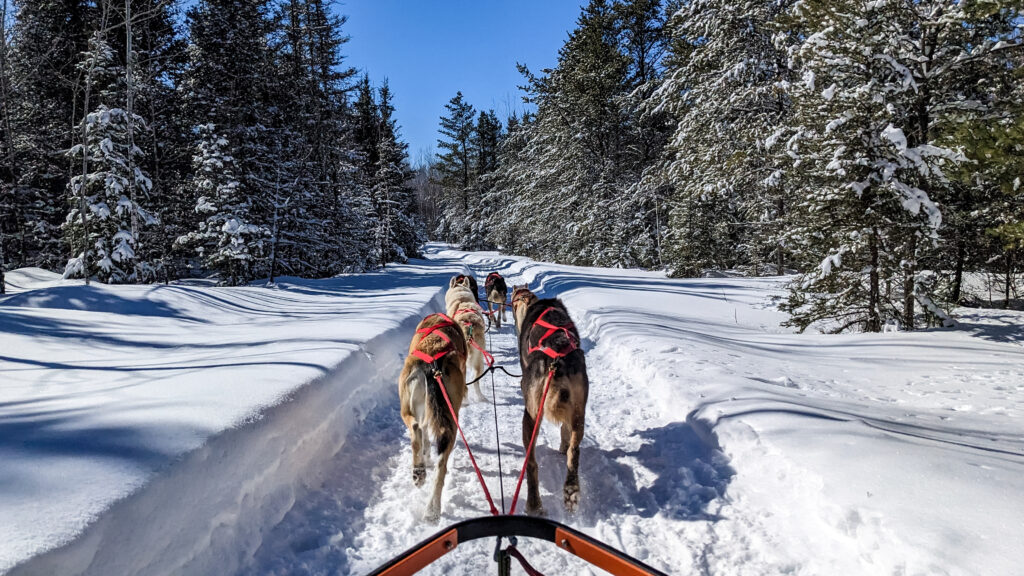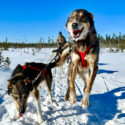Don’t let go.
The mantra runs through my head as seven lean dogs pull me through the snow. My hands, stuffed into two layers of gloves and going numb, grip the handle of my sled. The world is silent save for the sound of dogs running. The sun glares down on us. The team moves along at a steady pace, grabbing mouthfuls of snow from the high drifts for a quick cool down. Their feet hit the ground rhythmically, kicking up white flurries. It feels like living.
My guide, Jake Hway, sits in the sled in front of me, calling out “Gee!” or “Haw!” whenever we hit a fork in the path to tell the dogs which way to go. The lead dogs, Fuzz and Ace, follow his directions without hesitation. It’s a trust that goes deeper than dog and musher.
“There’s a common misconception that you have to be ‘the alpha’ with these dogs,” Hway said. “But with them, it’s more like a family. The alpha is the mother or father figure. They’re the sense of security, the source of confidence for the group. That’s what the dogs are looking for from us.”
But it goes both ways. If you hesitate, or push the dogs too hard, they’ll take matters into their own hands. After all, this is their passion — we’re just along for the ride. As Hway puts it: “They’ve been doing this for hundreds of generations. We’re the newbies here.”
Here at Chilly Dogs Sled Dogs in Ely, Minnesota, bringing newbies like me into the pack is the Hway family business. They’ve been taking visitors on sled dog adventures through the backcountry of Northern Minnesota since 2005, snow or shine. Hway himself has been at it since the age of 13.
“It’s less of a business and more of a lifestyle,” Hway said. “Dogs give you everything, so we need to give 100% back.”
Chilly Dogs is unique because they primarily take in retired racing dogs — several of their dogs have even competed in the world-famous Alaskan race, The Iditarod. Kobear, a black dog with white eyebrow spots, made it to Mile 900 of the famed race before he got into a bag of chicken skins and had to sit out the last stretch because of tummy troubles. I don’t think he regrets a thing.
The Hway family business is a haven where dogs like Kobear can continue their favorite activity, even when they can no longer keep up with the 150-mile days. Chilly Dogs is built around what’s best for these older dogs. They get to keep running at a schedule that works for them and get important physical and mental stimulation as they age. With two trips a day, the dogs average about 25 miles daily — a walk in the park for these racing veterans.
Meet The Team
The team pulling Hway and I through the snow is still making good time. I keep my foot on the brake — a piece of snowmobile tread — to keep the eager dogs from pulling too far away from the rest of the teams. Most of the dogs on our team are new to Chilly Dogs — Hway prefers to keep the younger dogs on his team because they’re still building trust together. Four sleds of his more experienced dogs, ranging from age six all the way up to 14 or 15, bring other visitors along behind us.
All of these dogs are Alaskan Huskies. There’s no breed standard, and they vary in size, shape and color. Unlike many other purebred dogs like Golden Retrievers, they’re not bred for looks — they’re bred for work. Their diversity makes them a great team that can take on huge challenges like the 1,100-mile Iditarod. They can overcome whatever conditions they face on the trail with a good mix of strength, speed and heart.

Leading our team are Fuzz and Ace. Fuzz has been at Chilly Dogs for just over five years. He was the leader of a mid-distance team, and while he never raced on a trail, he’s happy to take the lead on this one. Hway relies on him, especially when it comes to leading the newer dogs. Ace, on the other hand, is newly retired at eight years old. Another mid-distance leader, he brings the energy to Fuzz’s steady manner. The kennel he came from advised Hway against taking him because of how expressive and vocal he was, but the two have really hit it off.
Coming up behind them are Donkey and Rascal. At three years old, Donkey is one of the youngest of the 90-some dogs at Chilly Dogs. Even though he’s a little young, Hway assures me he’s got the right personality for this type of work. Donkey is patient, good with the customers, and “having a blast,” according to Hway. To his right is Rascal, who spent last summer in Alaska doing tours with tourists off of cruise ships. The Wisconsin-born dog has traveled more than most people do.
Lone in the middle is Rover. He’s the steady central force for this team, having been at Chilly Dogs for six years. Rover came from a long-distance running team, so he’s not much of a risk-taker, but he’s all systems go when Hway asks for it.
Bringing up the rear are Shaggy and Hunter. Honey-colored Shaggy is only five years old but has plenty of racing experience under his belt. Hway says he has “eyes that can see into your soul.” Hunter comes from an accomplished racing team and competed in the John Beargrease Sled Dog Marathon, a tradition of Duluth, Minnesota. Hunter was born at Chilly Dogs, and after his successful career, has returned for retirement.
Maybe that seems like a lot to remember, but Hway and his family know their dogs by heart.
“One of the most common questions we get from people is, ‘Do you remember all their names?’” Hway said. “Of course we know their names. We know everything about them. Their body language, what they’re thinking or what their attitude is that day. We know how they’re feeling.
“But it’s not like matching a name to a face. A dog barks from a mile away and I know who it is. A dog walks up behind me and I can tell who it is by the sound of their feet on the snow. A dog jumps on my back and I know who it is by their weight. It’s a very deep relationship that we build. It’s more than friendship — it’s family.”
Since 2005, Chilly Dogs has given over 100 retired sled dogs a new home and a renewed purpose. Their family grows by the year. With each dog they take in and each tour they lead, the Hways continue to preserve the legacy and culture of Northern Minnesota. After all, it was sled dogs that made the North a reality — with one man brave enough to lead them.
Building the North
When John Beargrease was born in 1858, the wilderness north of Duluth was largely untouched. A footpath along the shores of Lake Superior was the only means of travel between Duluth and Thunder Bay, Ontario. As sons of the Anishinaabe chief, Beargrease and his brothers traveled it frequently. Their method of choice? Sled dogs.
For nearly 20 years, Beargrease delivered mail and supplies between Two Harbors and Grand Marais every week. It was an 80-plus mile trip, and he made it with just four dogs. His record time was 28 hours, a feat that, over a century and a half later, modern mushers can barely top. Beargrease was pivotal to the development of the North Shore, and for the past 43 years, his legacy has been honored with the John Beargrease Sled Dog Marathon.
The race is over 300 miles, starting in Duluth and ending in Grand Portage. It draws mushing superstars from across America, including Ryan Redington, 2023 winner of the Iditarod and grandson of Joe Redington, Sr. — otherwise known as the “Father of the Iditarod.” Ryan won the Beargrease Marathon in both 2018 and 2020 with his team of dogs. Oh, and he happens to be good friends with Hway, too.
Celebrating Beargrease’s legacy with a sled dog race is fitting, but work like his still goes on to this day. There are paved roads in most places now, but in protected areas like the Boundary Waters Canoe Area Wilderness, the only way in is by canoe — or dog sled.
In Minnesota’s Superior National Forest, the National Forest Service uses teams of sled dogs to haul materials into the Boundary Waters. Without the dogs, they’d have no way to get heavy fire grates and boardwalk planks out to these remote areas. The dogs can easily pull several hundred pounds of weight over the ice in the winter, and when it thaws in the summer, rangers can head out by canoe and start building with the materials. By canoe alone, the process would be nearly impossible.
While dog sledding has largely become a recreational sport made famous by races like the Iditarod and the Beargrease, it’s still a very real part of Northern Minnesotan culture and their way of life. For the Hway family, their dogs are both their livelihood and their best friends. Thanks to Chilly Dogs, anyone can experience this slice of Minnesotan culture.
“I can explain everything about dog sledding, but until you actually grab hold of that handlebar and feel the power they have, you can’t understand it,” Hway said.

Return To Reality
The dogs funnel into the yard in a stream of black, brown and white. I slow them with the brake before stepping on it hard. It bites into the frozen ground, steadfast against the seven dogs straining at their leads. Hway gets out of the sled and starts unhooking the dogs with the practiced ease of someone who’s done this a thousand times — and he has. He brings them two by two to the kennels, and I watch them go, wishing I could say goodbye.
When the last of the dogs is unhooked, I step off the brake and they pull the sled away. It’s over. The dogs bark in the distance as I walk toward the house. I wanted to go back and see them one last time, but Hway tells me they’re eating dinner — fine dining of raw meat and kibble. After the workout they just had, I’m happy to let them eat in peace.
But it feels too sudden.
One minute we were racing along the white snow drifts, carving paths through the silent wilderness, and the next I’m walking to my car for the long drive back to the city. Fumbling to pull my car keys out of the inner pocket of my coat is an abrupt reality check.
And the worst part? I don’t know if I’ll ever go dog sledding again.
It’s not just because of the long drive to get this far north (although that’s certainly a factor). With the sport reduced to recreation and the looming force of climate change, the future of dog sledding can’t be certain. The Minnesota DNR clocked the top ten warmest and wettest years of Minnesota in the past 20 years, and projections hint that by 2050, summer highs might reach 95 degrees — a seven-degree increase in just 25 years. While for now, Hway reports that their winters are as cold as ever, who knows what the next ten years will bring?
Well, one thing is for certain — rain or shine, snow or not, the Hway family will be out on the trails with six dogs and a sled (and if there’s no snow, there are always scooters, bikes and ATVs). It’s what they love. And guess what? After a few hours out on the trail with them, I love it too.
The season has wrapped up for Chilly Dogs, but come November they’ll be taking people out on the trail again. Maybe it will be 30 degrees and sunny, or maybe it will be 10 below. There’s only one way to find out. Book a trip and embark on your own dog-powered adventure into the Great White North. And once you’re on that sled, whatever you do…
Don’t let go.



Leave a Reply